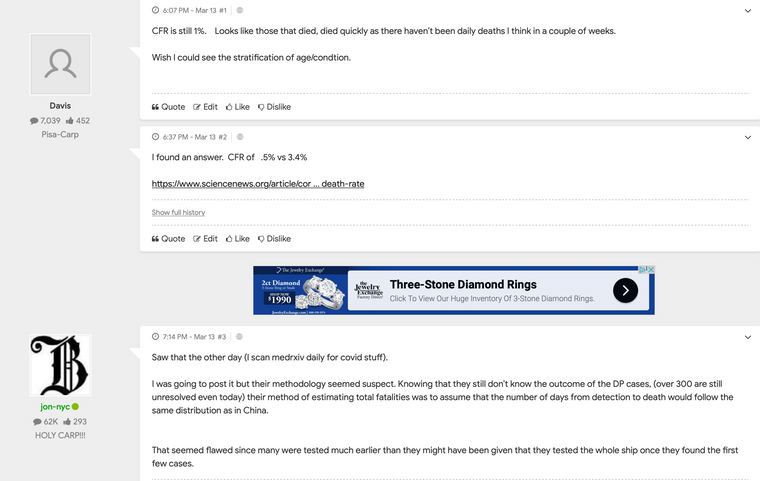CDC revises fatality rate
-
Right. So sample bias in serology because serology test recipients were unlikely to be nursing home residents.
That’s a point, though even if every New Yorker over 75 was positive and unaccounted for in the serology sample that would bring us to 25% infection rate rather than 20%
NYC deaths by age per100,000
Over 75 is greater than all the other categories combined by well (vastly) more than double.
https://www.statista.com/statistics/1109867/coronavirus-death-rates-by-age-new-york-city/
-
@Loki said in CDC revises fatality rate:
NYC deaths by age per100,000
Over 75 is greater than all the other categories combined by well (vastly) more than double.
https://www.statista.com/statistics/1109867/coronavirus-death-rates-by-age-new-york-city/
That link implies 16500 total deaths in nyc rather than 21000. (196/100000)*8400000 = 16500
-
@Loki said in CDC revises fatality rate:
In NYC you were almost 100 times as likely to die if you were over 75 than under 44.
Loki by now we all fully understand your discount function on Covid deaths. Does it have any bearing on the accuracy of the CDC model?
-
@Loki said in CDC revises fatality rate:
In NYC you were almost 100 times as likely to die if you were over 75 than under 44.
This sort of distinction seems important, in a debate about whether to shut down a society. And all the biggest impact rhetoric of the debate, such as counts of lives lost or lives that could have been saved, completely ignores it.
-
If we were talking about lockdown measures I wouldn’t have found the comment out of the ordinary.
But that makes some sense out of the inability to see the obvious arithmetic impossibility of the CDC estimate in NY. I thought we were arguing about a CDC model not lockdown measures. But I guess we’re always arguing about the lockdown.
-
@Loki said in CDC revises fatality rate:
In NYC you were almost 100 times as likely to die if you were over 75 than under 44.
Loki by now we all fully understand your discount function on Covid deaths. Does it have any bearing on the accuracy of the CDC model?
It is not impossible that a model built from a large set of data will seem arithmetically at odds with some subset of that data, which might be an outlier. Are we concentrating on NYC because it seems to be an outlier, while ignoring other sets of data which seem to corroborate the model? The CDC model is actually under no obligation to conform to every subset of the data, it is meant to predict in general. And yes, it is conceivable that the NYC numbers imply fatality rates which overestimate the general case.
-
@jon-nyc said in CDC revises fatality rate:
No I think they’re wrong by minimum a factor of 2.
My guess is 0.5<IFR<0.75
CDC revised the estimate again. As a reminder, in the first post of this thread, their 'best estimate' scenario had an IFR of 0.25. Their new update, published Friday, increased it to 0.65%, smack in the middle of my range.
https://www.cdc.gov/coronavirus/2019-ncov/hcp/planning-scenarios.html
-
@jon-nyc said in CDC revises fatality rate:
No I think they’re wrong by minimum a factor of 2.
My guess is 0.5<IFR<0.75
CDC revised the estimate again. As a reminder, in the first post of this thread, their 'best estimate' scenario had an IFR of 0.25. Their new update, published Friday, increased it to 0.65%, smack in the middle of my range.
https://www.cdc.gov/coronavirus/2019-ncov/hcp/planning-scenarios.html
@jon-nyc said in CDC revises fatality rate:
@jon-nyc said in CDC revises fatality rate:
My guess is 0.5<IFR<0.75
CDC revised the estimate again. As a reminder, in the first post of this thread, their 'best estimate' scenario had an IFR of 0.4. Their new update, published Friday, increased it to 0.65%, smack in the middle of my range.
https://www.cdc.gov/coronavirus/2019-ncov/hcp/planning-scenarios.html
I’ll take credit too as the Diamond Princess example I was using very early on seems to have stood the test of time.
-
You're being a bit too generous with yourself. You were touting the DP when there were only 6 or 7 fatalities and pointed out that it needed to be adjusted downward because of the age distribution on the ship. You pushed back repeatedly when I pointed out how many of the cases weren't resolved yet.
Now there are 13 deaths out of 712 cases, for an IFR of 1.8%.
-
@jon-nyc said in CDC revises fatality rate:
No I think they’re wrong by minimum a factor of 2.
My guess is 0.5<IFR<0.75
CDC revised the estimate again. As a reminder, in the first post of this thread, their 'best estimate' scenario had an IFR of 0.25. Their new update, published Friday, increased it to 0.65%, smack in the middle of my range.
https://www.cdc.gov/coronavirus/2019-ncov/hcp/planning-scenarios.html
@jon-nyc said in CDC revises fatality rate:
@jon-nyc said in CDC revises fatality rate:
No I think they’re wrong by minimum a factor of 2.
My guess is 0.5<IFR<0.75
CDC revised the estimate again. As a reminder, in the first post of this thread, their 'best estimate' scenario had an IFR of 0.25. Their new update, published Friday, increased it to 0.65%, smack in the middle of my range.
https://www.cdc.gov/coronavirus/2019-ncov/hcp/planning-scenarios.html
Good job jon.
